Conventional wisdom says ride sharing services like Uber undermine public transit. After all, why sweat it out in the subway when, for a few extra bucks, you can be driven around in luxury? But a new report finds the more people use shared modes of travel like bike and ride sharing, the more likely it is they use public transit. Not only that---shared services make passengers healthier, reduce the need for car ownership, and "complement public transit, enhancing urban mobility."
That's the rosy picture painted in "Shared Mobility and the Transformation of Public Transit" from the American Public Transportation Association. While the ease and flexibility of using a service like Uber or Lyft clearly help riders who can afford it, it's not clear how to extend those advantages to the poor, the elderly, or those with disabilities.
It's an impressively comprehensive report that addresses an important question, says Paul Lewis, vice president of policy and finance at the Eno Center for Transportation, which was not affiliated with this study. "There's this outstanding question as to whether these new shared mobility services are complementary to public transit or competitive," he says.
The answer seems clear. The survey of 4,500 "shared-use mobility consumers" in Austin, Boston, Chicago, Los Angeles, San Francisco, Seattle, and Washington, DC, found people who regularly use shared services "save the most money and own half as many cars as people who use public transit alone," the report says. (It did not quantify those savings.) Uber and Lyft rides are more likely to replace a trip in a car than a trip by transit. More than half the respondents who listed ride sharing as their preferred mode of travel listed journey by automobile as their second choice, about 15 percent said they'd use the bus or train instead. Ride share use spikes during the overnight hours, when public transportation systems are closed, filling a gap in service. That's why, the report finds, cities "should identify opportunities to engage with [sharing services] to ensure that benefits are widely and equitably distributed."
Cue the caveat: Those surveyed had an average household income of $90,926, 70 percent more than the US median of $53,657. It's an indication that Uber and Lyft users are wealthier than most Americans, or at least that the report claiming these benefits built its findings on those with disposable income. The ride sharing companies rush to put down this image of elitism. They point out that their services are often less expensive than conventional taxis. David Plouffe, Uber's chief advisor, says ride sharing's "value proposition" is a big deal in underserved areas like Chicago's South Side, LA's Compton and Watts, and West Philadelphia. They point to services like Lyft Line and Uber Pool, in which customers share rides for reduced fares that can drop below $5.
If the goal is to expand these benefits to everyone, even those relatively affordable prices aren't low enough. Transportation is already a major expense for low-income communities. "The cost burden of commuting for the working poor is 6.1 percent [of income] compared with 3.8 percent for other workers," a 2008 Brookings report found. That kind of strained budget doesn't leave much room for regular or occasional rides with Uber and Lyft, even with the benefits. "That's something that the industry will continue to grapple with," Lewis says.
There's also the fact that ride sharing services have barriers to access, notably the requirement for a smartphone and a credit card. In a report addressing new technologies and transportation last month, the Eno Center said the combination of not being able to use Uber or Lyft, and having Uber and Lyft force traditional models like taxis and public transit out of business, is a real risk for some: "Lower income travelers that do not have access to a smartphone or cannot afford the new services might be left worse off as the traditional transit services they rely upon lose market share."
So how do you take the upsides of those private services---their flexibility, ease of use, and profitability---and adapt them to serve the users to whom they are the least accessible? Well, no one really knows. Lyft is exploring some ideas, says Emily Castor, the company's director of transportation policy. That includes working with the San Francisco Bay Area's Metropolitan Transportation Commission to use its ride sharing platform to help run its 511 carpooling program. In January, Lyft announced it is working with the National Medtrans Network in New York City to transport 2,500 patients to medical appointments each week.
Such partnerships are a good approach, Lewis says. "If the public transit agencies don't engage with this directly soon, then they're putting themselves at risk of being a competitor and not a complement," he says. What that looks like "is fuzzy right now ... this is a brand new field." But there's no doubt that "those kinds of partnerships are going to be crucial."
So now it's up to cities, public agencies, and government officials---hopefully with the help of the nimble private sector---to figure the rest out.

